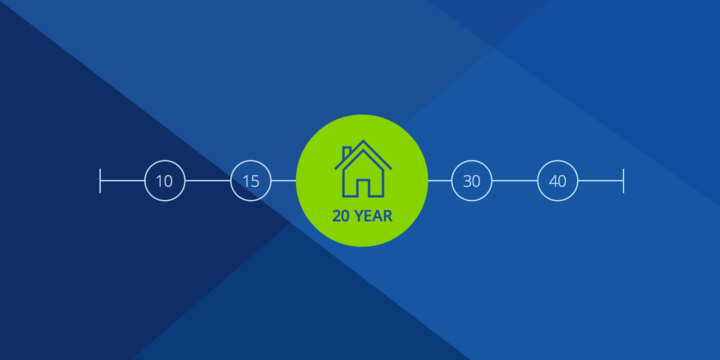How to Apply for a Mortgage
Mortgage applications may seem a bit intimidating. This simple guide walks you through all the types of information that you or your lender will need to provide for the application.


Written by Alycia Lucio on May 2, 2025
Reviewed by Neil Swanson
To apply for a mortgage, you'll need to actively be working with a lender or find a lender you trust who can offer you the best loan terms. The mortgage application process involves sharing financial documents, completing an application and undergoing an underwriting process before you can close on a home. If you're a first-time home buyer, the process may seem confusing — you're not alone. Just remember, a professional lender can you walk you through the requirements, timing and expectations. You’ll gain confidence as you move through the process of applying for a mortgage.
Most homebuyers apply for a mortgage when they've found a home they love, and their offer on the house has been accepted by the seller. This is because most mortgage applications ask you to include the address and purchase price of the home. If you haven't found a home just yet, consider getting pre-approved. This will help you fast track your mortgage application once you're ready. Here are the key steps involved in the mortgage application process.
Mortgage application process
1. Prep your finances
Review your credit score and income to ensure you meet home loan requirements. A favorable credit score is usually in the high 600s to 700s range. While the amount of income a homeowner spends on their mortgage can vary, aim to spend between 25% and 35% of your monthly income on housing costs. You can use an Affordability Calculator to determine a comfortable budget.
Your lender will advise you to not make any major purchases from the application until the home is fully closed. You should also avoid acquiring new lines of credit. Both of these actions can increase your debt, which impacts the portion of your income available to repay your loan. Increasing your debts at this crucial time is risky because the loan processor will re-confirm your credit and debt during underwriting.
2. Gather your documents
Your mortgage application requires much of the same documentation required for your pre-approval, unless more than 30 days have passed, at which time you’ll need updated documents such as paystubs and bank statements. Most lenders carry your pre-approval information over to your loan application as a starting point.
Documents needed for your mortgage application
- Last two years of W-2s
- Last 30 days of paystubs
- Last 30 days of other income streams: alimony or child support
- Last 60 days of bank statements
- Social Security Number or Individual Taxpayer Identification Number
- Copy of the Purchase and Sale Agreement, including property address and purchase price
- Verbal or written confirmation to make a hard inquiry on your credit
3. Begin your application
The vast majority of lenders use the same application template, called the Uniform Residential Loan Application or Fannie Mae Form No. 1003. This standard application helps the lender determine if they are able to approve you for a loan program, and how much money they will lend you. The mortgage application process can usually be completed online. Your lender will help you if you have questions.
It’s likely that your lender will have questions or requests as you go through the application and underwriting process. And getting your loan approved on time is key to closing on schedule. Be sure to respond quickly whenever your lender or representatives from their office reach out.
4. Specify the loan type
You’ll need to specify the type of loan you’re applying for. That could be FHA, VA, conventional, or USDA. You’ll also need to confirm the amount borrowed, length of loan, interest rate and terms. Your lender may pre-populate this section for you.
5. Indicate the property information
You will need to write in the details of the property you want to buy — its address, the year built, the legal description of the property and the number of units in the building. Your real estate agent will detail this on your purchase and sale agreement.
6. Detail the purpose of the loan
Next, you will need to write in why you want the loan: Is it to purchase the property, a refinance, a construction loan or some other reason? (If the property is a refinance or construction loan, you will need to provide additional details on the improvements you plan to make, existing liens and a few other details.)
7. Include personal information
You and your co-borrower (if applicable) must fill in your personal information, including:
- Your name (and any co-borrowers)
- Current address (and whether you rent or own)
- Previous address — if less than two years (and whether you rented or owned)
- Social Security Number (SSN)
- Individual Taxpayer Identification Number (ITIN)
- Phone number
- Marital status
- Date of birth
- Number of years of school
- Number of dependents
On the last section of the mortgage application, you will be asked about your race, ethnicity and gender but you are not required to provide such information. The government requires lenders to ask applicants for such demographic information to monitor lenders’ compliance with federal equal credit opportunity, fair housing, and home mortgage disclosure laws.
8. List employment information
You and your co-borrower (if applicable) will need to list out details of your employment. This includes:
- Name of employer or company
- Address
- Phone number of your employer
- Your position and job title
- The type of business
- The number of years you've held that position
- How long you've been in the field
If you’ve been in that position for less than two years, you’ll need to fill out previous employment details as well. If you are self-employed, you will likely need to provide a minimum of two years’ personal and business tax returns and current financial statements.
9. Document monthly income and housing expenses
You and your co-borrower (if applicable) will need to include details about your gross income — this includes your base employment income, overtime, bonuses, commissions, income from dividends, interest, rental income — and combined monthly housing expenses. These expenses include current rent or mortgage payment, mortgage insurance, taxes and homeowners association fees — basically any expense related to housing.
10. Detail assets and libailities
You and your co-borrower (if applicable) will need to list out what you own (your assets) and what you owe (your liabilities). Assets include bank accounts, investments, real estate, cars and businesses owned. You will need to list out the details (name of bank, account number) and market value for each of these. Liabilities include credit card balances, installment loans (i.e., car loans, student loans, boat loans), alimony and child support. For each, you will need to include account number, monthly payment amount, months left to pay and total unpaid balance. Some of these fields may be pre-populated based on data your lender already has on you, but you’ll want to verify their accuracy. This step allows the lender to analyze your current debt structure so that they can determine the amount of mortgage loan that you qualify for.
11. Source your down payment
Your lender wants to confirm that the money you’re using for your down payment belongs to you, and isn’t owed to anyone else. They’ll ask for the source of your down payment and analyze your bank statements to determine if you have the down payment amount and cash reserves required for the loan transaction. If a family member or friend gifted you money for your down payment, you’ll need a formal letter that confirms it was a gift, not a loan. Your lender can help you with this.
12. Include the purchase and sale transaction terms
Your lender will write out the details of the loan–the purchase price, estimated closing costs, estimated prepaid items, loan amount and other details. You’ll want to review these figures for accuracy and make sure they match the Loan Estimates you received during the application process.
13. Make declarations
You will need to answer a series of yes or no to questions about your financial history; whether you have declared bankruptcy within the past seven years, whether there are any outstanding judgments against you and whether you have had a property or loan foreclosed upon or have been a party to a lawsuit. If you answer yes to any of these questions, you will need to provide further explanation. If any of these situations apply to you, it’s best to let your lender know ahead of time.
14. Sign the application
Finally, you’ll need to sign this application in two places. At the top of the application, you and the co-borrower (if applicable) need to sign the form to acknowledge that you understand the terms listed at the top of this application. You also need to check a box to show whether the lender should use the income or assets of the co-borrower (if applicable) when determining the loan details. At the bottom of the loan application, you and your co-borrower will need to sign again, acknowledging that all the information provided on the loan application is true.
You will have to sign certain documents in person. It may be possible to sign some electronically depending on the lender. By law, the lender has three days to provide you with an official Loan Estimate, which is an accurate estimate of the final loan costs at such a point in time based on the information relied upon by the lender.
Can you switch lenders during the mortgage application process?
Once you have the Loan Estimate, you have the opportunity to compare final costs between multiple lenders. Although submitting the loan application is a demonstration of commitment to move ahead with that lender, it's not a binding commitment. It’s possible to switch lenders at any time, even after submitting a mortgage application.
How long does the mortgage application process take?
The application itself might take you less than an hour to complete if you have documents gathered and your pre-approval information automatically populates several fields. The overall purchase process with financing usually takes between three to five weeks. Without any missing information, some lenders can approve your application in as little as two weeks.
The important time frames to focus on are your closing timeline (30-45 days on average) and a 45-day grace period where any mortgage-related hard credit inquiries are considered as a single credit hit by all three credit bureaus.
What happens after you submit your mortgage application?
Once your application is signed and submitted, you’ll progress to underwriting, loan processing and finally closing. This post-application stage can feel like a continuation of the loan application because new contacts from your lender’s office and the title company will reach out to collect additional documentation.
Underwriting
A loan underwriter will read all of the information provided in your loan application and flag any missing information or circumstances that require additional documentation or clarification. They’ll verify your earnest money deposit and request a transaction receipt. They’ll also send your application to a title company to begin reviewing the property title (more on that later).
Expect an email from the reviewer when your loan is conditionally approved, meaning your loan should be fully approved once you satisfy their requests for further information.
Appraisal
During underwriting, the reviewer might request an appraisal to make sure the amount you’re paying for the home is in line with how much it’s worth. Buyers are responsible for the cost of the appraisal, and it’s often rolled into your closing costs. If an appraisal is expected, the cost should also appear on your Loan Estimate.
Processing
Next, a loan processor will work with you to collect the missing information flagged during review. The loan processor will communicate back and forth with you until everything is complete. They’ll fully confirm your employment, credit score and check for any fraud alerts related to your name or SSN or ITIN. When your mortgage file is complete, the processor will pass it back to the reviewer for approval.
Loan approval
You will receive confirmation of the final approval of your loan. At least three days before your closing date, you’ll receive your final Closing Disclosure. Take time to review the disclosures to make sure they accurately reflect the terms of your loan and the anticipated closing costs. These might vary slightly from your Loan Estimate provided earlier in the process, but your lender should have communicated any changes and provided updated disclosures as required throughout the process. If everything looks correct, you should electronically sign the Closing Disclosure.
Closing
In most states, you will close your mortgage loan with an escrow company such as a title company. At the title company, a separate closing agent (if there is one) has been reviewing the title of the property to ensure it is free and clear, with no outstanding liens. If everything goes to plan with the title company sign-off and final loan approval by your lender, the final closing paperwork will be sent to the title company. You’ll then visit the title company to sign the documents in person, in the presence of a notary. Your lender may or may not attend closing.
Note: Some states like Georgia, North Carolina and Massachusetts, are attorney closing states where an attorney will facilitate the closing of your mortgage loan.
You’ll transfer your closing payment, usually by wire or cashier's check, and the title company will record the sale by updating the property title under your name.
Always be honest and upfront about answering questions your lender asks, whether you’re providing documentation, disclosing gift money for your down payment or sharing prior credit concerns. This will help ensure you have no surprises and that nothing prevents you from getting a mortgage.

How much home can you afford?
At Zillow Home Loans, we can pre-qualify you in as little as 5 minutes, with no impact to your credit score.
Zillow Home Loans, NMLS # 10287. Equal Housing Lender
Get pre-qualifiedHow much home can you afford?
See what's in reach with low down payment options, no hidden fees and step-by-step guidance from us at
Zillow Home Loans.
Zillow Home Loans, NMLS # 10287. Equal Housing Lender
Calculate your BuyAbility℠



